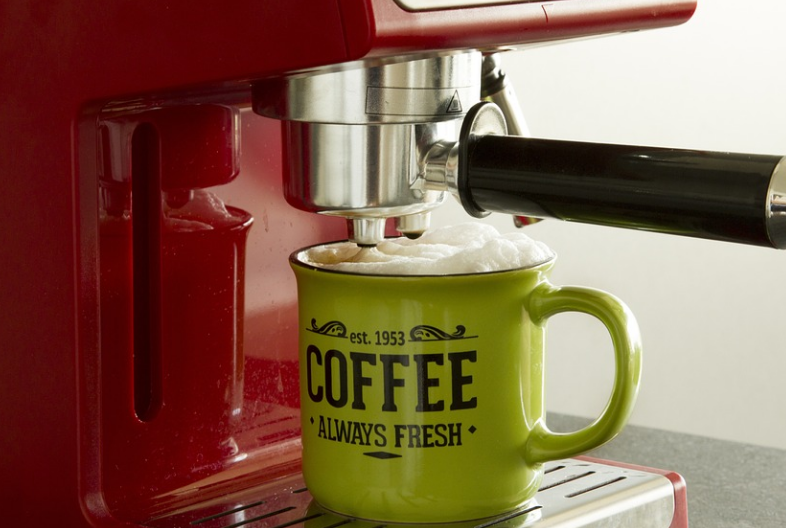How to clean a Bunn coffee maker? You should make a solution by mixing one part vinegar with two parts distilled water. Calcium deposits are easily broken down by vinegar’s acidity. Start a brewing cycle after adding the descaling solution to your coffee maker. Run a brewing cycle with only water to perform at least three to five rinses. Continue reading, you will learn more details to clean a Bunn coffee maker.
Table of Contents
Quick List to Clean a Bunn Coffee Maker
- To prevent turning it on accidentally in the middle of a clean, unplug the machine from the outlet.
- Mix warm water with a mild detergent or soap.
- Cleaning the machine’s exterior requires soaking a cloth in the detergent solution.
- To get rid of the detergent, rinse the cloth and clean the appliance once more.
- Take the machine’s spray head off.
- Use the long end of the spray head cleaning tool or a different tool that is similar to clean the interior of the spray head housing while the spray head is still separated.
Why You Should Clean Your Coffee Maker?
You should clean your coffee maker frequently for a variety of reasons. You can greatly benefit from a purified machine, from a shorter brew to fewer bacteria. Here are a few:
- Faster Brew Time
Your coffee maker’s internal scaling and mineral deposits can cause the water flow to become backed up. As a result, your coffee will take longer to brew and drip. A clean machine, however, will enable a constant flow of water and provide you with a quick cup of coffee to start your day.
- Proper Function
As was already mentioned, scaling buildup may obstruct the water flow required to brew your coffee. Having a problem with the machinery is caused by a lack of water flow. A spotless coffee maker will work well and accurately.
- Longer Lifespan
Cleaning your Bunn coffee maker will ultimately protect the equipment, allowing you to use it for a long time to come.
- Lower Risk of Bacteria
When brewing coffee, your coffee maker uses moisture as well as heat. Because of this, your machine is a haven for the growth of bacteria, yeast, and, occasionally, mold. For those who have allergies, this may trigger reactions, and it may even result in infections.
- Better Tasting Coffee
Everyone detests a bitter cup of coffee, and dirty coffee makers are frequently to blame. A machine’s internal thermometer may occasionally become damaged by dirt. You may have a less-than-flavorful experience if the temperature isn’t hot enough.

What You’ll Need to Clean a Bunn Coffee Maker?
It will be advantageous to have some supplies on hand before you begin. Except for a spray head cleaner, the majority of the equipment required is the simple household furniture. For cleaning the machine’s spray head, Bunn manufactures a specialized tool. Although a spray head cleaner isn’t strictly necessary, having one on hand makes the process much simpler. You ought to think about purchasing one because they aren’t very expensive.
- Soft rag or cloth
- Mild detergent
- Distilled water
- Vinegar
- Bunn spray head cleaning tool
How to Clean a Bunn Coffee Maker?
At the very least, we advise cleaning your Bunn coffee maker once per week. It’s best to clean your machine more frequently, but one to two times per week strikes a good balance between effort and cleanliness.
- Before you begin cleaning it, make sure the machine is turned off. To prevent turning it on accidentally in the middle of a clean, unplug the machine from the outlet.
- Warm water and a mild detergent or soap should be ready. This mixture is what you’ll use to clean the machine’s exterior.
- Use a cloth that has been dipped in the detergent solution to scrub the machine’s exterior. Pay close attention to the area near the spray head to make sure you don’t miss any spots.
- Rinse the cloth, then use it to clean the machine once more. It’s crucial not to leave the detergent on the surface for an extended period of time. Even mild detergents can harm surfaces if they come into contact with them for an extended period of time.
- From the machine, remove the spray head. Clean the spray head openings of any accumulated coffee residue using the spray head cleaning tool or another pointed object. Depending on how recently you cleaned the spray head, this step might take some time. Before continuing, take your time and check to make sure the spray head is clear.
- Use the long end of the spray head cleaning tool or another similar tool to clean inside the spray head housing while the spray head is still disconnected. Don’t be surprised if there is a lot of buildups to remove because this is a common trouble spot that is prone to mineral deposits and residue.
- Reinstall the spray head on the appliance, then use your freshly cleaned Bunn coffee maker.
How to Descale a Bunn Coffee Maker?
Unfortunately, cleaning is only half the battle. Particularly in areas with hard water, coffee makers can accumulate mineral deposits over time. The calcium that is left over after water evaporates on a surface is primarily what makes up scale deposits. If scale deposits are left in your machine, they will accumulate and may eventually completely clog it.
Fortunately, descaling a Bunn coffee maker is a simple and quick procedure. Here’s how to do it.
- Make a solution by mixing one part vinegar with two parts distilled water. Calcium deposits are easily broken down by vinegar’s acidity. To fill your Bunn’s coffee maker, prepare enough solution.
- Start the brewing cycle after adding the descaling solution to your coffee maker.
- Running a brewing cycle with just water will result in at least three to five rinses. After descaling, if you don’t thoroughly rinse the machine, your coffee will taste like vinegar.

How Often Should You Descale?
There is no universally applicable answer to the question of how frequently one should descale one’s, coffee maker. Your machine might need to be descaled as frequently as once per week if you live in an area with exceptionally hard water. On the other hand, if your water is soft, you might only need to describe it once or twice a year.
Examining your bathtub and sinks will help you determine the hardness of your water. You have hard water if a white buildup appears around the drain. If you’re still unsure after checking your drains, you can buy a water testing kit and quantify the amount of hardness in your water. Going into that much detail is typically not necessary.
When Does Coffee Maker Need to Be Cleaned?
Numerous indications that your coffee maker requires a thorough cleaning can be found if you look closely. Clean your coffee maker regularly, every time you brew is the best course of action. Ignoring these warning signs may lead to a broken machine and bad coffee.
Here are a few common things you should watch out for:
- Your coffee is awful.
- The inside of the coffee maker is stained.
- Your coffee takes a while to finish brewing.
- Anywhere inside your machine, you can find chalky material.
- Instead of flowing freely into the carafe, you can see and hear the water sputtering.
- There isn’t as much coffee being produced by your coffee maker as usual.
What Are the Best Cleaning Solutions?
Three super-cleaning ingredients that are risk-free and efficient to use on your machine are lemon juice, baking soda, and vinegar. Another great alternative is mild or unscented dish soap, but only for cleaning the machine’s or the carafe’s exterior.
See why these organic cleaning solutions are the best for coffee makers.
Lemon
Lemons are one of nature’s most effective sanitizing agents because of their high acid content. It can remove sediments from your coffee maker and hard water stains thanks to its antibacterial properties. Furthermore, as an added bonus, it will linger with a delightful citrus scent.
Baking Soda
Due to its affordability and versatility around the house, baking soda is another popular option for cleaning coffee makers. With the help of this cleaning tool, the coffee pot’s stains are removed along with bacteria and odors.
You can clean your coffee maker in a number of ways, and you can even combine these cleaning agents to make a more potent solution. Mixing equal parts lemon juice and baking soda is one option. You will quickly clean your machine with this deodorizing and disinfecting paste, leaving you with a fresh coffee maker and peace of mind.

Vinegar
An efficient cleaning solution for frequently used appliances like a coffee makers is vinegar. It can simultaneously decalcify the inside of your machine, get rid of residue, and disinfect it.
Where is Germs Lurk in Coffee Makers?
You might be unpleasantly surprised to learn that the disposable coffee cups you and the rest of your office use every day are crawling with germs if you work in an office environment. It makes sense when you think about all the dirty hands that have contaminated the cups because everyone who drinks coffee will eventually touch them.
One of the dirtiest parts of the machine is the handle for the coffee maker. It doesn’t matter if you’re at home with your roommate, family, or significant other or in an office with a shared coffee maker—the handle is a breeding ground for germs in both situations.
Helpful Tips to Prevent Coffee Maker Germs
- Remove the coffee grounds, throw away the filter after each use, and dry with a paper towel or clean cloth.
- For a clean brew the next morning, wash the carafe and soak it in warm, soapy water.
- To dry out any moisture that might lead to mold, open the top cover of your coffee maker.
- After each use, place your carafe and basket in the dishwasher for a more thorough cleaning.
- After each use, clean the handle with a disinfectant or warm, soapy water.
How Long Do I Leave Vinegar in My Bunn Coffee Maker?
Depending on the Bunn model you own, combine ½ to 13 cups of vinegar and ½ to 2/3 cups of distilled water in a bowl. Pour the vinegar and distilled water mixture into the water reservoir. then start the brewing process.
What to Avoid When Cleaning Your Coffee Maker?
It’s great that you’re taking the initiative to clean your coffee maker, but there are a few mistakes you should steer clear of.
- Avoid using cleaning products that contain chemicals. This could damage both the machine and you.
- Before beginning the cleaning procedure, make sure you have read the instruction manual for your Bunn coffee maker. It may contain some specific instructions that you don’t want to overlook.
- Disassembling any parts that aren’t mentioned in this article could result in more confusion (and mess) than you intended.
- Avoid using soaps with strong scents because they may contaminate the coffee grounds and alter the flavor.
- Cleaning a hot or plugged-in machine could injure you. Instead, use a cold water supply.
Conclusion on Clean a Bunn Coffee Maker
Although it is important, learning how to clean your Bunn coffee maker is not as enjoyable as mastering the art of making great coffee. A Bunn coffee maker can consistently produce delicious coffee for many years with routine care and maintenance. This guide should have made it easier for you to understand how to maintain your machine and removed any uncertainty from what, if you’ve never done it before, can be a daunting process.





